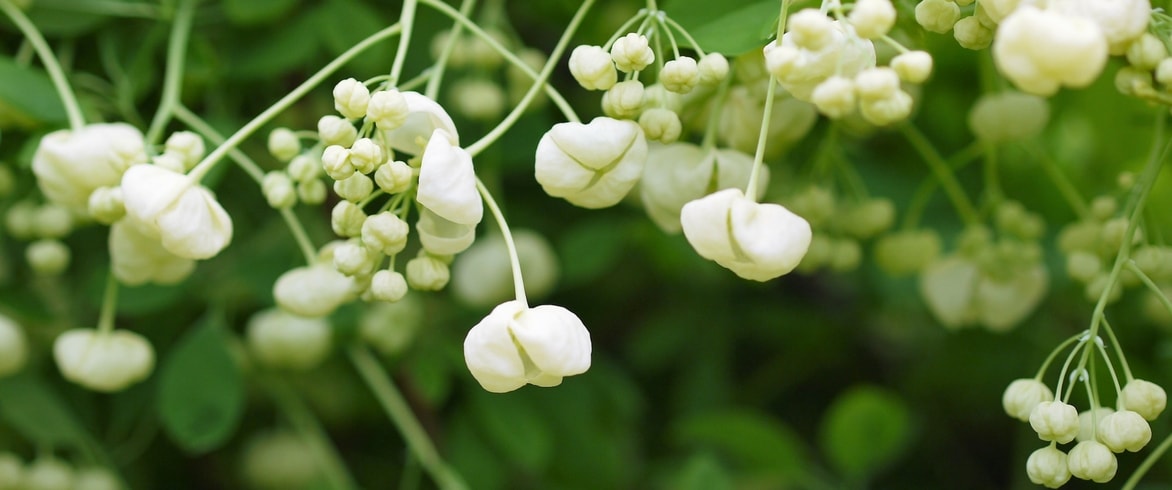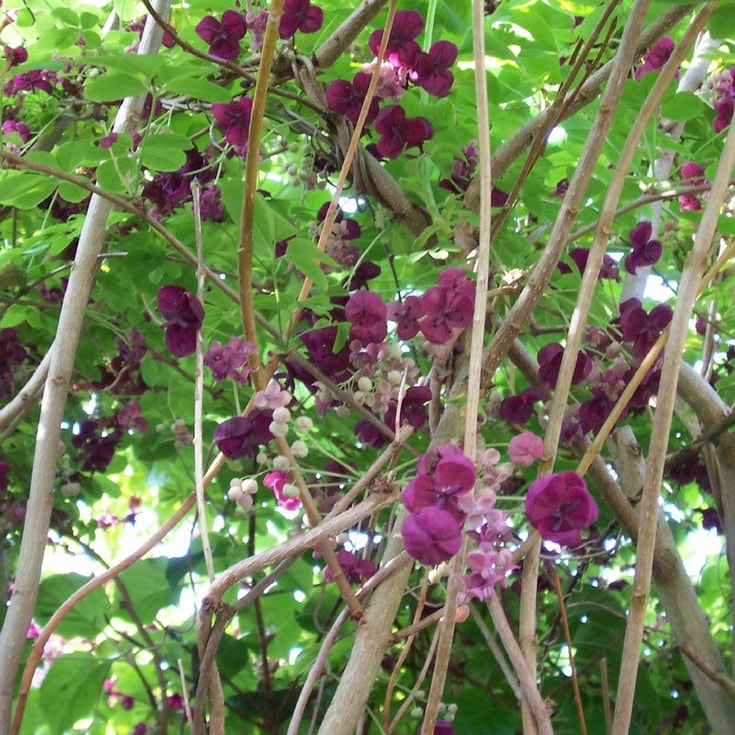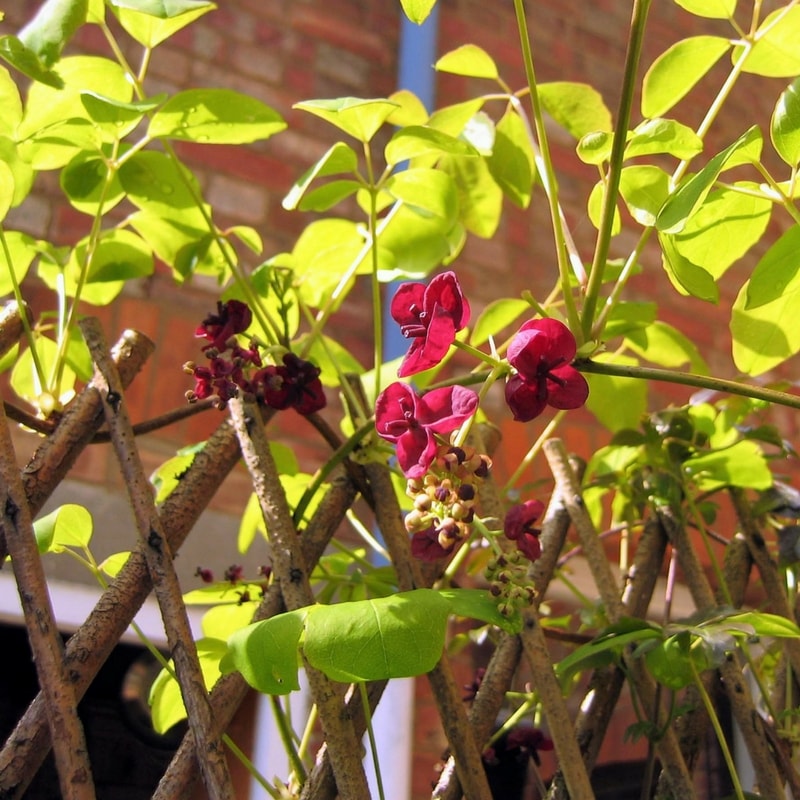
Akebia: Planting, Pruning and Care
Contents
The Akebia in a few words
- Akebia is a twining climber with early blooming purple-mauve flowers
- Its exotic-looking foliage is deciduous to semi-evergreen
- It thrives in partial shade but tolerates non-scorching sun
- Easy-going and exuberant, it’s perfect for quickly covering a wall, pergola or tree
- Highly vigorous yet light-filtering, it won’t smother its supporting plants
Our expert's word
Less temperamental than a clematis and as vigorous as a wisteria, Akebia quinata, commonly known as Akebia or “Chocolate Vine”, is a lesser-known climbing plant of Asian origin. It is remarkably resourceful in twining around anything within reach—quickly scaling and transforming even the dreariest wall into a lush tapestry.
Easy to grow and undemanding, Akebia quinata, as well as the hybrid Akebia x pentaphylla, offers a generous and early bloom from April to May. Its numerous vanilla-scented flowers emerge as unique bell-shaped blossoms, opening wide to reveal deep pink hues ranging from purple-red to wine-red, with some creamy-white varieties.
But that’s not its only asset! Depending on the variety, its elegant foliage remains semi-evergreen in mild winters.
When planted in groups, it produces unusual bluish, edible fruits that split open when ripe. Its lush foliage and tolerance to almost any exposure make it highly versatile in the garden, particularly when paired with other climbers like a climbing rose, a honeysuckle, or a clematis.
This exotic-looking, twining vine is perfect for dressing up walls, pergolas, and fences—or even climbing up a tree. Once well-established on a suitably sized support, this exuberant beauty can reach 5 to 8 metres in three to five years. Hardy, it withstands temperatures as low as -15°C.
Decorative and low-maintenance, this striking climber—still uncommon in gardens—delights with its originality!
Botany
Botanical data
- Latin name Akebia
- Family Lardizabalaceae
- Common name Akebia, Chocolate Vine
- Flowering April to May, fragrant
- Height 3 to 8 metres
- Exposure sun, partial shade
- Soil type Heathland (Acidic), neutral
- Hardiness -15°C
Native to the temperate forests of Japan, Korea, and China, the Akebia, also known as “Chocolate Vine”, belongs to the little-known Lardizabalaceae family, which includes Stauntonias and Holboellias. It thrives in thickets and forest edges at higher altitudes.
Introduced to Europe in the mid-19th century, the Akebia enjoyed great popularity. After becoming rare following extensive cultivation, the Chocolate Vine is making a strong comeback today. This genus comprises four species: Akebia quinata (Five-leaf Akebia), the most cherished species with its clusters of violet-purple flowers, Akebia trifoliata (Three-leaf Akebia), rarely planted, Akebia x pentaphylla (Hybrid Akebia), and the rarest, Akebia longeracemosa (Long-cluster Akebia).
Reaching maturity in three years, this vigorous woody plant is twining—its stems cling to supports by coiling around them. It quickly forms a sprawling vine of 6 to 10 metres, ideal for covering fences or trees. Exuberant, it can grow several metres in a single season. In less favourable conditions, it may take up to five years to establish properly. At maturity, it covers 6 to 8 m²: like all climbers, its stems coil around larger plants (trees, shrubs) to reach sunlight. Less aggressive than Wisteria, its stems won’t damage structures. However, ensure it has space to spread and provide a sturdy, large support.
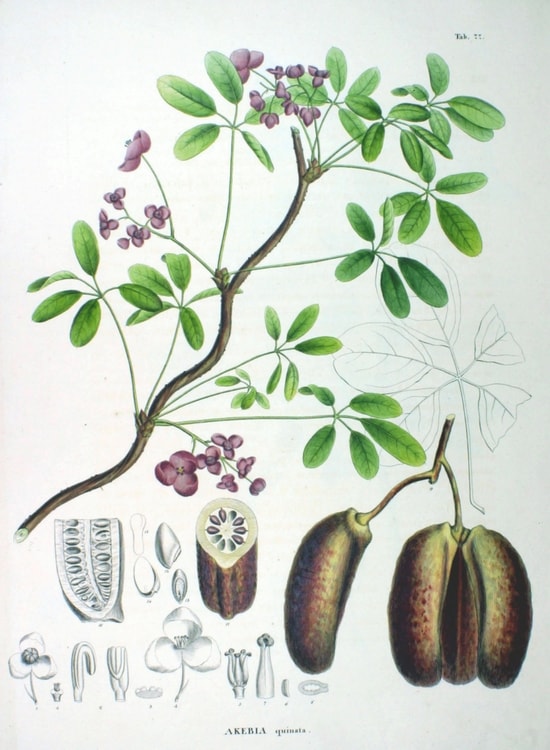
Akebia quinata: botanical plate
The Akebia produces highly distinctive flowers, remarkable for their originality and delicacy. Early-flowering, it blooms from mid-April to May on the previous year’s growth. It bears beautiful pendulous clusters 8-12 cm long, adorned with bell-shaped flowers. Narrow and cup-shaped, each flower has three shell-like petals ranging from burgundy-red to soft pink, cream to violet-purple, with six erect stamens in chocolate or pink hues. Some varieties, like Akebia quinata ‘Silver Bells’, feature bicoloured flowers—pale mauve and silvery-white—of striking originality. This cheerful, nectar-rich bloom emits a subtle vanilla fragrance. Remarkably generous, flowering lasts 3 weeks to a month.
A monoecious plant, the Akebia bears both male and female flowers on the same vine. Female flowers are larger, fleshy, and darker—these develop into fruits if spring and summer are warm enough. However, the plant is not self-fertile and requires a second nearby specimen. At least two different varieties must be planted to ensure cross-pollination and fruit production.
In September-October, fleshy, bloom-covered fruits appear only after warm spring and summer conditions on fertilised female plants. They take an unusual form—arched, fleshy “cucumbers” 5-8 cm long, lilac-blue or violet. When ripe, the fruit splits open, revealing large black seeds. Hanging from branches, these edible fruits are harvested when they begin to split (September-October) but are primarily ornamental. Their translucent pulp is rather bland, though mildly sweet with an apple-like taste.
We recommend collecting and destroying these rare fruits to prevent the vine from becoming invasive through self-seeding. Akebia quinata is considered invasive in several U.S. states and southern Britain. Fortunately, it spreads mainly vegetatively (via layering), as fruiting is relatively rare, especially in colder climates.
The Akebia is a “clingy” plant, easily attaching itself by twining stems around supports.
Round, green when young and brown at maturity, these stems form a tangle of slender branches bearing luxuriant, highly decorative foliage. Graphic and airy, the leaves frame the flowers beautifully. Its compound, alternate, palmate leaves divide into three to five obovate-elliptic leaflets—apple-green in spring, bluish underneath, turning purplish-red in autumn.
Deciduous, its foliage may remain semi-evergreen in mild winters—a valuable trait for concealing unsightly walls.
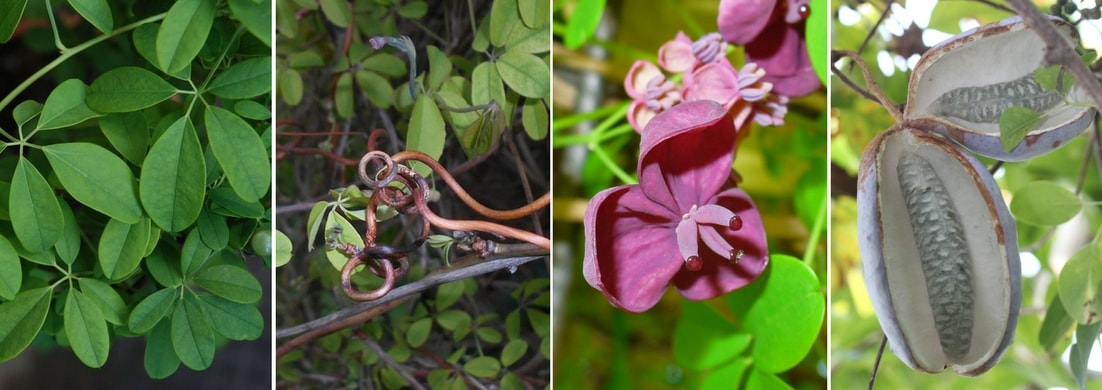
Foliage, stem, flowers, and fruits
Easy-going, the Akebia thrives in temperate climates, including urban areas. Hardy and cold-resistant, it withstands temperatures between -13°C to -18°C when mature. Below -8°C, leaves may drop, but the plant will regrow.
One of few climbers tolerant of shade, the Akebia adapts to almost any garden position. In the wild, it grows in dense, shaded woodlands. Ideally, plant with roots in cool shade (not wet) and foliage in sun, sheltered from cold winds to protect early blooms from frost damage. East-facing sites are ideal for morning sun. It tolerates full sun (except in southern regions) if soil remains cool, mulched in summer.
Though adaptable to neutral or slightly acidic garden soil, it prefers light, fertile, moist, well-drained soil. Once established, it withstands temporary drought. Its shallow roots allow versatile planting.
The Akebia needs space and appropriately sized supports to flourish. Its twining stems cling to pergolas, trellises, walls with wires, or trees, pairing well with climbing roses, evergreen Honeysuckle, or Clematis for sequential blooms. Perfect for disguising ugly walls, underplant with perennials (Columbine, Schizostylis, Loosestrife) to keep roots cool.
Species and main varieties
This genus includes four climbing species, but mainly cultivated are Akebia quinata (Five-leaf Akebia), the type species and also the best-known of the genus with its clusters of purple flowers, Akebia x pentaphylla (Hybrid Akebia), and Akebia trifoliata (Three-leaf Akebia). There are many cultivars with white flowers such as Akebia quinata ‘Cream Form’ or variegated foliage like Akebia quinata ‘Variegata’, and pink-flowered varieties such as Akebia quinata var. ‘Rosea’. The main selection criterion is flower colour.
The Most Popular
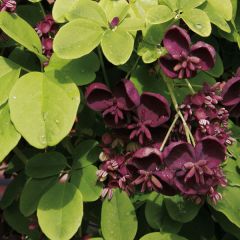
Akebia quinata - Chocolate Vine
- Blütezeit May, June
- Höhe bei Reife 6 m
- Akebia trifoliata or Three-leaf Akebia: features chocolate-coloured flowers that stand out against bronze foliage when young, later turning dark green. This climber is slightly less vigorous than A. quinata and A. × pentaphylla. Its mauve fruits are smaller than those of Akebia × pentaphylla.
Our Favourites
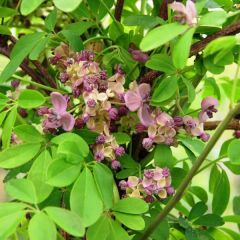
Akebia quinata Silver Bells
- Blütezeit May, June
- Höhe bei Reife 6 m
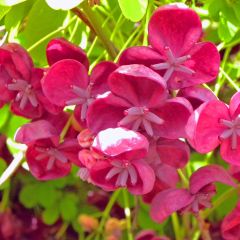
Akebia quinata var. Rosea
- Blütezeit May, June
- Höhe bei Reife 6 m
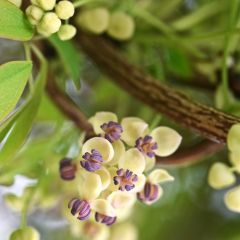
Akebia quinata Akebia Cream Form
- Blütezeit May, June
- Höhe bei Reife 8 m
Other Interesting Varieties
- Akebia quinata ‘Alba’ with white flowers and pink stamens.
- Akebia quinata ‘Amethyst Glow’ with red flowers.
- ‘Purple Bouquet’ for its dark violet flowers and more compact, darker foliage than the type species.
- Akebia quinata ‘Bookside Variegata’: Same characteristics as the type species but with white-yellow variegated leaves.
Planting
Where to Plant Akebia?
Easy-going, Akebia is a temperate climate plant that can be grown anywhere, including urban areas. Hardy (the Akebia pentaphylla is the least hardy of its species), it can withstand temperatures around -15°C, sometimes even lower in sheltered spots if its base is well mulched. Late frosts may damage young shoots.
Sun, partial shade, and even shady spots: its tolerance to almost all exposures makes it highly versatile in the garden, provided it’s sheltered from wind. We recommend planting it preferably in partial shade, especially in warm regions, and ideally facing east so the plant enjoys morning sun.
Its shallow root system allows it to thrive almost anywhere. Very adaptable to soil types, it does well in neutral or slightly acidic garden soil, though it prefers light, fresh, dry, and well-drained soils for optimal growth. Once established, this vine can tolerate temporary droughts. To protect it from summer heat, plant a few evergreen perennials (Carex, Ophiopogon, Heucheras…) at its base to provide shade.
This vigorous plant requires an airy location: its mature spread covers 6 to 10 m², and it can become somewhat invasive!
Akebia needs a sturdy support to flourish. A robust trellis is essential. Its twining stems with tendrils easily cling to various structures—pergolas, trellises, or even unsightly walls. It can also climb trees or fences. Though vigorous, it remains lightweight and won’t strangle nearby plants like Wisteria. Still, choose a location where it can be easily managed and carefully select the support for this vigorous climber.
When to Plant Akebia?
Plant Akebia in spring (March to May) or preferably in autumn (September to November) to enjoy its early flowering.
How to Plant?
Once established, Akebia requires little care. The secret to this vigorous climber lies in proper planting.
In a 50 cm x 50 cm hole, spread a layer of gravel for drainage and to prevent root moisture in winter. Mix the excavated soil with organic fertiliser, compost, or ericaceous soil. Place the potted plant, then backfill with the same mixture.
Train the first branches onto the support; they’ll then cling on their own. Plant perennials around the base to retain summer moisture or mulch with leaves, pine needles, or bark. Water moderately.
Given its rapid growth and expansive spread, one plant per m² will cover 6 to 8 m² within a few years.
Maintenance and Pruning
This beautiful woody plant requires little care. Its branches easily twine around supports. As with many climbing plants, help its stems to climb when first establishing. Once well settled, the Akebia can practically manage on its own. To protect it from frost, mulch the base during the first few winters, and in regions with harsh winters. You can also mulch in summer to keep the base cool if you haven’t planted ground cover plants.
Each year, in spring before new growth begins, add compost. In summer, water only when the soil is dry several centimetres below the surface.
It has no known pests or diseases.
→ Also read our advice sheet: How to grow Akebia in a pot?
Pruning Akebia
With vigorous growth, Akebia responds well to shaping pruning. Maintenance is limited to light pruning, always after flowering, to control its spread and remove weak shoots.
Solutions exist to curb its exuberance: it’s best to avoid letting branches creep along the ground, as they can root and spread the vine invasively. Akebia dislikes severe pruning and doesn’t always respond well to this type of cut. You can cut back one particularly vigorous stem to ground level every two years.
→ Learn more about pruning Akebia in Gwenaëlle’s tutorial.
Which support to choose?
The Akebia needs support to grow, as its stems are not rigid enough to bear its own weight. However, it clings to its support on its own; you just need to guide the shoots initially, then the stems will wrap around by themselves. It can lean against a wall, wind around a tree, climb up a fence, or cling to a trellis. You can choose between wooden trellises (rot-resistant exotic woods require little maintenance), PVC, or steel, which is useful for these vigorously growing plants that will eventually weigh down the trellis.
Propagation
By cuttings
This is the simplest and least tedious method to propagate Akebia. In August-September, take semi-hardwood or semi-ripe cuttings of 10 to 20 cm, depending on the size of the Akebia being propagated (i.e., from stems that grew in spring and begin their transformation from softwood to hardwood around July-August). Cut a healthy current year’s shoot at an angle, just below a bud. Plant them in a light, well-draining growing medium. Regularly mist the cuttings with a sprayer. Pot them up as soon as they have formed roots. Overwinter them frost-free, in a cold frame or under shelter. Plant out in the ground the following spring.
→ Learn more in our tutorial How to take Akebia cuttings?
By layering
In late autumn, layer one of its vines by bending it towards the ground and burying a section to encourage rooting. Stake the aerial portion. By spring, you can separate the layer from the parent plant if it has sufficient roots. Otherwise, wait until late summer to sever the stem where it enters the ground.
Useful resources
- The finest range of Akebia is available here!
- Get inspired to dress your walls and pergolas with an original climbing plant!
- Akebia and its edible fruits: a hidden treasure
- Our tutorial: How to train Akebia in your garden?
- Akebia diseases and pests: our advice for treatment
- Subscribe!
- Contents


































